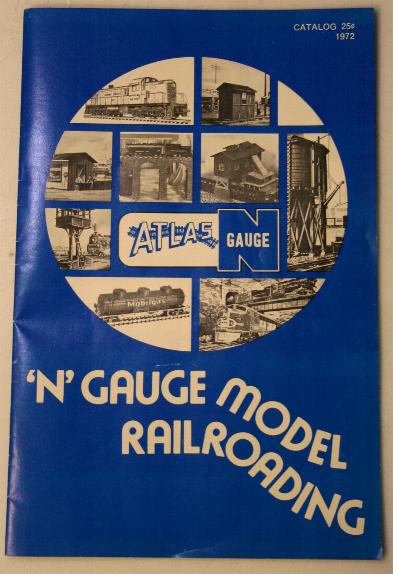
See a super-size pop-up image! (~231K)
A1G: The 1972 Atlas Catalog
©2001-2013 George J. Irwin. All rights reserved.
|
Special thanks to Michael Bishop for his help with this page.
| It's now been more than fifty years since Atlas Tool Company released their 1972 catalog. This document, among others, marks the transition from the A1G product line -- which, by my reckoning, ends with the 94 foot "whale belly" tank cars (the 3110 series) to the beginnings of the A2G product line, which, by my reckoning, starts with the beer can tank cars that are shown as "to be announced" in these pages. This page has reasonable size images of each of the pages of the 1972 Catalog, but as an extra bonus for those of you with larger monitors and sufficient bandwidth (not so much of a problem these days as it was when I first started this site!) there are also "supersize" images available here as well. These are several times actual size at least and will appear in a pop-up window (which you'll need to enable if necessary). |
|
| 
The cover features (besides the funky 1970s era font!) a collage of images of Atlas products-- several of
which are actually HO Scale, not N Scale! At the bottom right of the "world" of products is a bit of the
artwork for the cover of one of the A1G Train Sets. Also visible are the Union Pacific version of the RSC-2
diesel, the N Scale coal mine with composite gondolas being "loaded", and the 0-8-0 steam loco crossing an
Atlas Viaduct kit.
| See a super-size pop-up image! (~231K) |
|
| 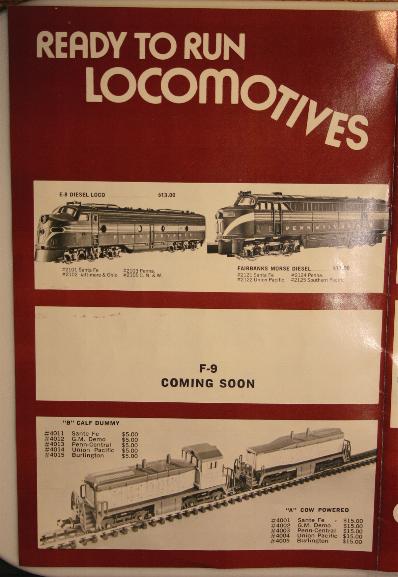
Page 2 offers another hint of what's ahead in the "Second Generation," namely, "F9 Coming Soon." But the
old standby E-8 diesel and the Fairbanks Morse "C-Liner" are still around. These are known for coming
down with what I'll call "metal fatigue" (although not nearly as bad as the "Zamac-itis" of some earlier
items in HO Scale!). Some copies also had motors that burned out quickly. My copy of the Pennsylvania
C-Liner ran for years. And speaking of years, or maybe decades, that's how long it took for the A1G C-Liner
to finally be superceded by another model (Life-Like's, in 2001 and again in 2006).
| Also on this page are the "cow and calf" set that Atlas had; these were released later by Rivarossi (which
manufactured them) and by Con-Cor.
|
|
| 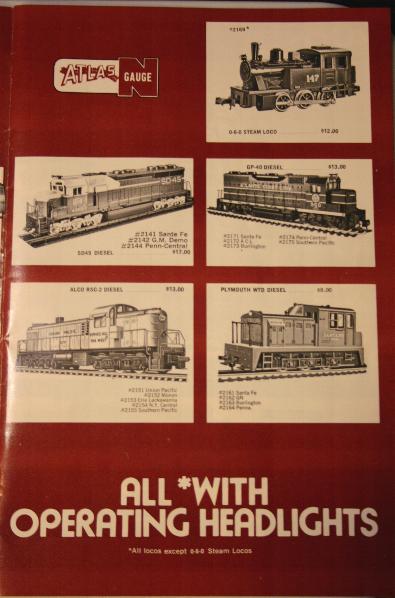
Page 3 shows the other diesels in the A1G roster, plus, in the top right hand corner, the famous "147" 0-6-0
steam locomotive-- famous for me, anyway, in that it was my first ever N Scale locomotive, included in my
first ever N Scale train set, back in 1969. And there is of course a direct path from that Train Set to
this website! Imagine how things might have been different if instead I'd gotten the AHM Train Set that
my brother received at the same time!
| Also on this page is the WDT Switcher, which, speaking of AHM, was also marketed by them. The RSC-2
diesel is the A1G locomotive that I come across more than any other. The SD-45 and GP-40 were made by
Mehano and were available under different brand names later.
|
|
| 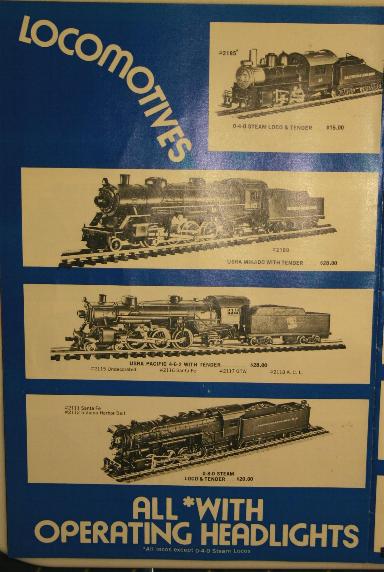
Page 4 shows the four larger steam locomotives in the A1G roster. The 0-8-0 was actually an Indiana Harbor
Belt prototype and it's unusual that it would be painted in that relatively less known roadname even though
that was correct! (The Santa Fe: Not so much.) Note that the #2180 USRA Mikado isn't shown with any road
names; if I recall correctly, some of these came with decals so the N Scaler could select from several
choices.
| See a super-size pop-up image! (~261K) |
|
| 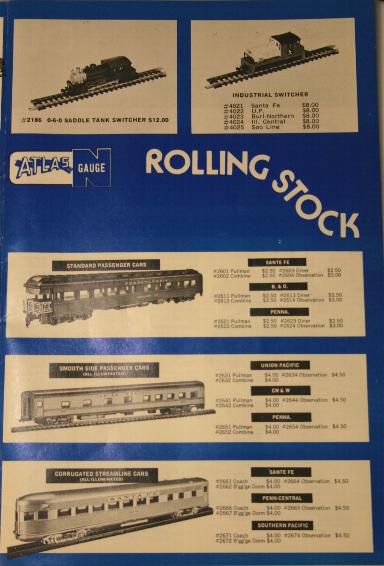
Page 5 shows the last two locomotives available. The 0-6-0 Saddle Tank was probably the last of the A1G
power, while I think that the "Industrial Switcher" was actually more like a Second Generation release.
If that's true, then it illustrates the difficulty of calling a specific "boundary" in time between the
two generations. In fact, A1G rolling stock continued to be sold even as A2G items were being
introduced and there was plenty of overlap at hobby stores. The "Industrial Switcher" was later offered
directly by Rivarossi and "clones" exist. It wouldn't surprise me to know that across all the different
variations of this general model, this has been the single most produced N Scale locomotive in history.
| Atlas shows how to get plenty of passenger cars listed on less than two-thirds of a page. First, show
just one example of each major body type, specifically "standard" (heavyweight), smooth-side streamline,
and corrugated streamline. Second, group the roadnames together. Yes, we know it's not "Sante Fe." Images of
all of these cars are visible here on the A1G site.
|
|
| 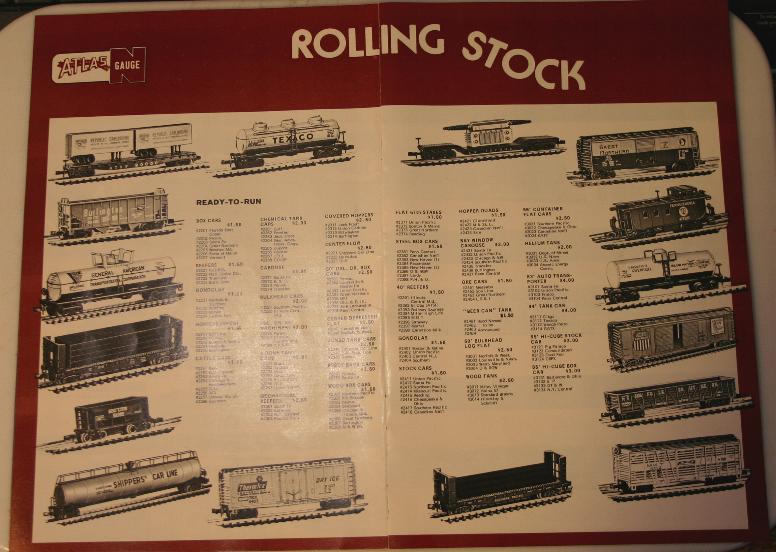
Pages 6 and 7 show the entire freight car roster available at the time--165 different cars!
Let's split that up...
| |
|
| 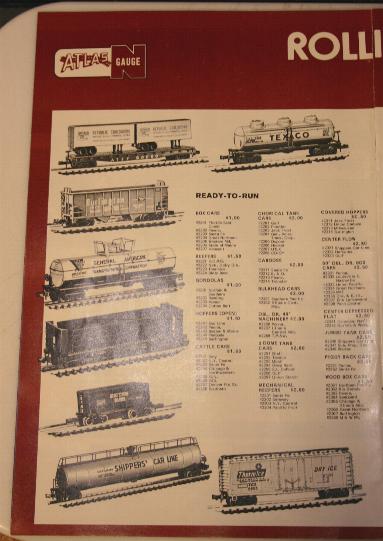
Ah, that's better. The releases are in catalog number order (the same way they are here on the A1G site).
Of note among the illustrations: the General American chemical tank car isn't depicted exactly the way the
model looks, particularly the platform around the dome; and the Texaco three dome tank car is depicted
exactly the way the model looks, including the transposed "TXC" reporting marks!
| In addition, the "Transfer" caboose listed here as Catalog 2274 "crossed over" from the A1G to the A2G
series. The "Transfer" didn't have a roadname, just a road number. This "scheme" (such as it is) appeared
on both caboose body styles. The A1G version of the caboose appears in Pennsylvania lettering on the next
page. Speaking of which...
|
|
| 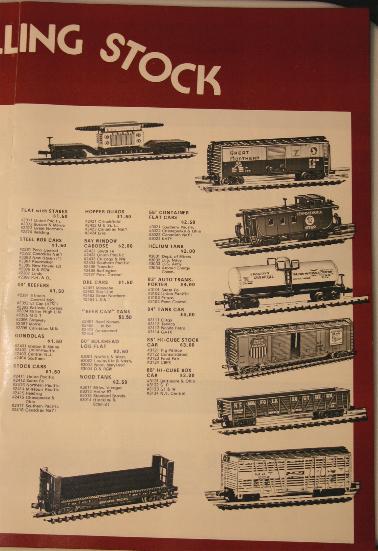
Page 7 features something that the A1G series never had-- a boxcar with opening doors! It's the Union
Pacific double door on the right. In fact, it's not even the same style door. Between Page 6 and Page 7,
the two and only roadnames of the bulkhead flat car are illustrated, though the #2281 Southern Pacific
had N&W reporting marks... as faithfully reproduced in the drawing!
| Also note in the second column of releases on this page, the presence of the ore cars-- I'm still
not sure whether these should be A1G or A2G-- and the "Beer Can" tank with "Road Names to be Announced"
which is definitely A2G as they were manufactured in the United States. Both "Beer Cars" and ore cars
are still being marketed by Atlas in their Trainman line, though not at $1.50 MSRP.
|
|
| 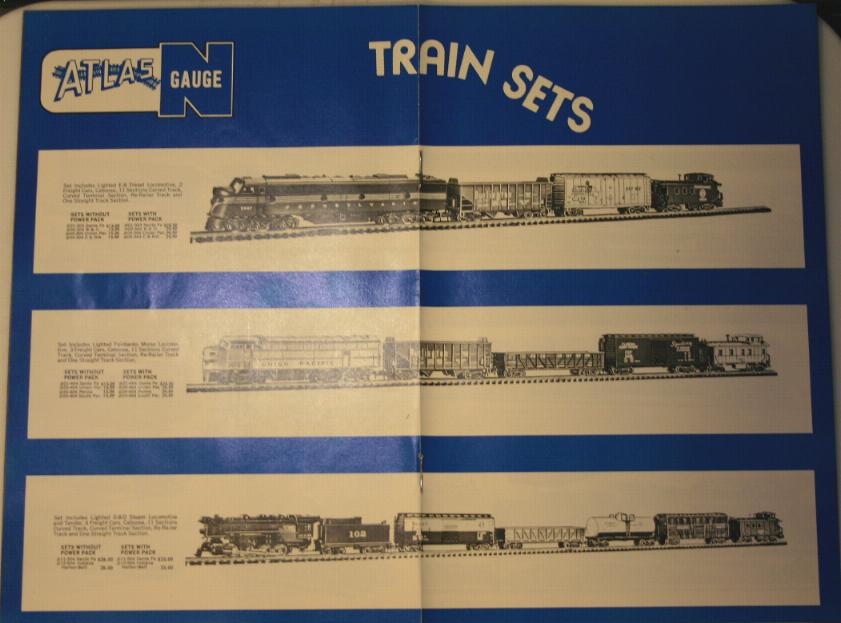
Pages 8 and 9 show three of the freight train sets available. Sadly-- for me, anyway-- the "147" set with
which I started my N Scale journey in 1969, three freight cars and the 0-6-0T steamer aren't among the
1972 lineup. Neither is the double loco set with a Powered A and Unpowered A F-M C-Liner with a few
freight cars-- that was my second set. However, there are three sets to choose from here, and more on the
next two pages.
| There's no good way to make the small print work on a two page illustration so there's either the super-size pop-up image (~314K), or a quick scroll down... |
|
| 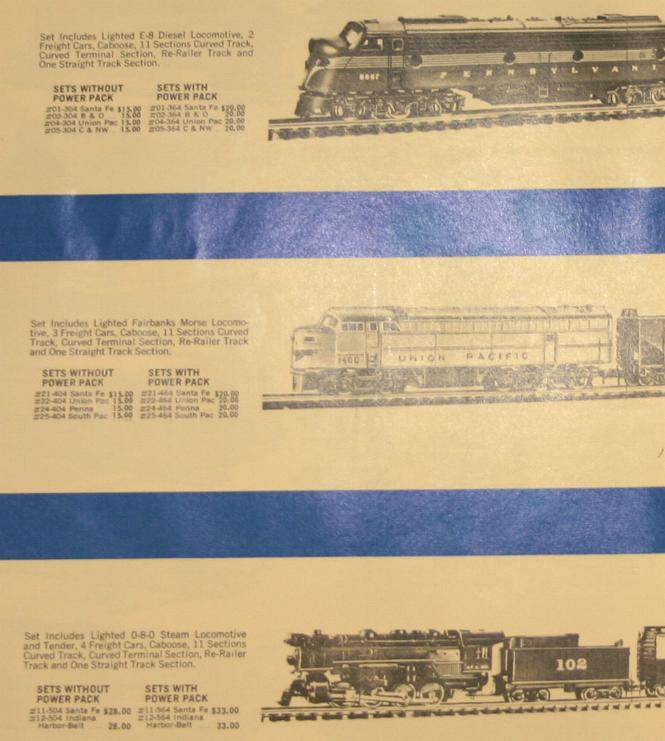
...to this grab of the text describing the train sets, from Page 8. Minimum wage in the United States in
1972 was $2.10 per hour, so $20.00 for a train set was not a bad deal. (And it was only $15.00 without the
power pack.) Each of these sets came with enough track to make the standard 21 by 26 inch oval: 11 sections
of 9 3/4 inch radius curve track, one 9 3/4 inch radius terminal track (remember those?), a piece of 5 inch
straight track, and a five inch straight rerailer track. That was how many of us started...
| |
|
| 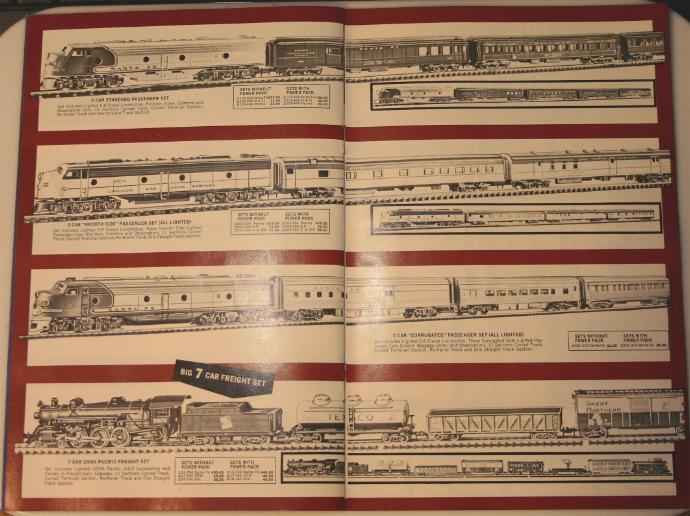
Well, this two-page spread is even harder to split up. It shows the three types of passenger sets
available, plus a "big seven car freight set!" pulled by an A1G Pacific steam loco. (We'll ignore the
anachronistic lineup of freight cars.)
| Once again, here's a super-size pop-up image (~438K)... |
|
| 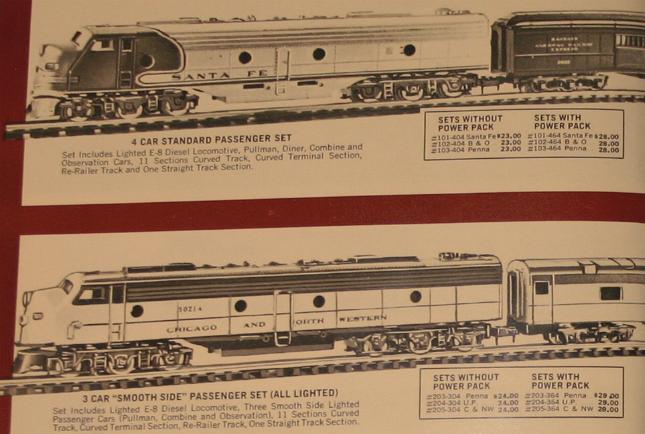
...and here are grabs of the descriptions of each of the sets: the first two...
|
| 
..the third (available only in Santa Fe;though there were Penn Central passenger cars of this type,
Atlas didn't have a matching locomotive)...
|
| 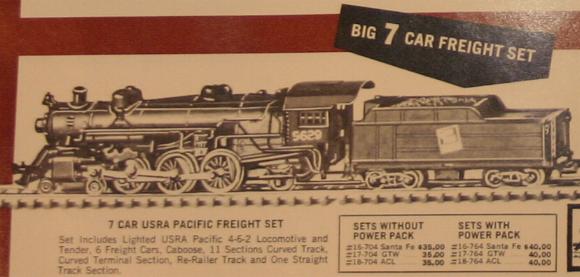
...and the fourth, that "7 Car Freight Set." It was the most costly of all of the sets available at the
time. The passenger cars and the Pacific probably didn't look all that great going around 9 3/4 radius
curves, but this wasn't unusual. Besides, in HO there were plenty of people running passenger trains
around 18 inch radius curves-- the equivalent sharpness. And meanwhile, Trix (via Aurora's 'Postage Stamp'
line) was selling train sets with 7 1/2 inch radius curved track! I still have some of it!
| |
|
| 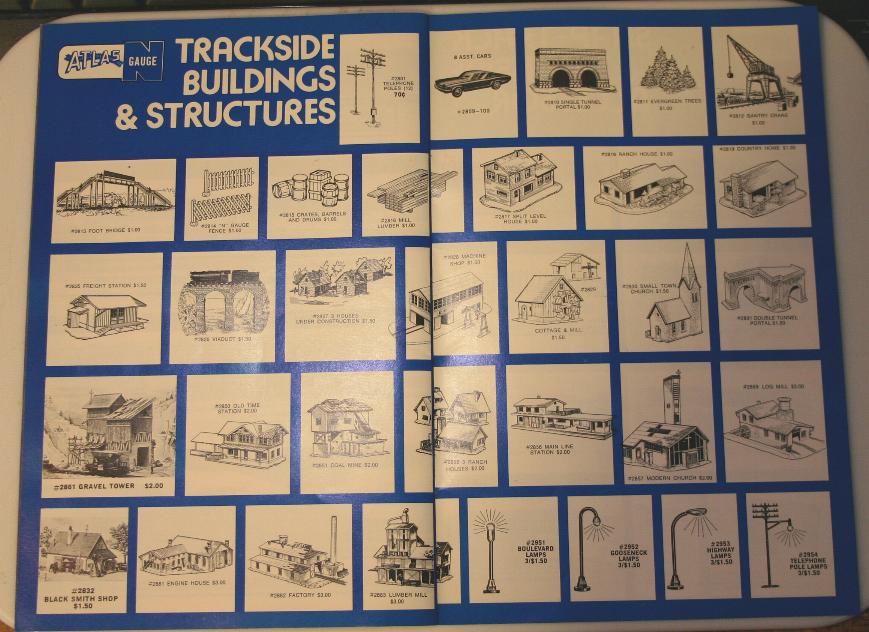
Atlas devoted two pages of the catalog to its "Trackside Buildings and Structures." And detail parts as well, as you can
see. Again, it's easier using the
super-size pop-up image (~278K). While all of the A1G rolling stock is now out of production, most
of the buildings on this page were and still are being marketed under various brand names after Atlas stopped
selling these kits under its own name. The original manufacturers were Pola and Faller. Oh, and Atlas still
does sell the "telephone poles" and the viaduct, the latter of which is an extremely compressed depiction of
the famous Starruca Viaduct in Northeastern Pennsylvania.
| |
|
| 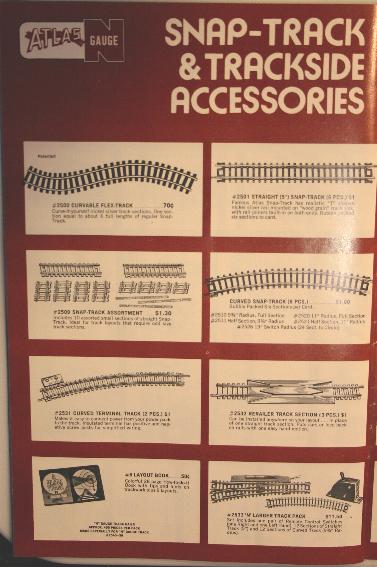
And then we get to the track itself, and a few "trackside accessories." Note how all of the standard
sectional track curved sections are listed together. These same five types (full and size 9 3/4 inch radius,
half size 9 3/4 inch radius, full and half size 11 inch radius, and full size 19 inch radius) are still
being sold today.
| Anyone remember the "larger track pack"? I've been trying to figure out how this expands a layout, or enables the construction of anything
other than a standard oval with a couple of spurs. Hmm, it might be interesting to see what the most
creative use of 12 curved sections, 12 straight sections, and two "switches" (turnouts) might be! Speaking
of "anyone remember," how about those switch controllers? They were smaller versions of what AHM was
marketing in HO Scale, and could be "ganged" together to make a whole set. Full-size fingers don't scale
down, however...
|
|
| 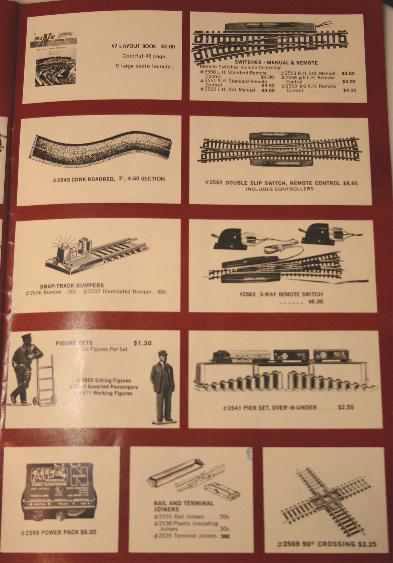
And don't we all wish that the prices for the manual and remote switches were the same as what was listed in
the 1972 catalog! On the other hand, it was still a task for me to save up for even a manual turnout back
then. The illustration of the turnouts shows what I believe to be the first design for the switch machines;
there have been several major changes since then. The double-slip and three-way switches are long gone out
of the Atlas offerings, but the good news is that they finally started offering a "Wye" switch! (And, of
course, a full line of Code 55 track as well.) Also gone: the illuminated bumper, the "power pack" and the
figure sets. Atlas doesn't sell its own cork roadbed either these days. But the line of crossings has
expanded quite a bit from just that 90 degree version. And the venerable guide "Nine N Scale Layouts,"
co-written by none other than the legendary track planning genius John Armstrong, remains available.
| See a super-size pop-up image! (~191K) |
|
| 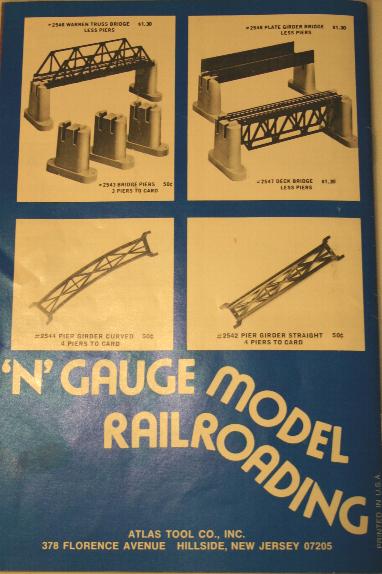
Finally, we reach the back cover, Page 16, on which the various bridge and pier products are illustrated.
With the exception of the "curved pier girder"-- which was a great idea!-- all of these products are still
available. The pier girder, as you might recall, was used to fill in the gaps between piers on the way up
a ramp to one of the Atlas bridges. The "wings" fit outside of the "tabs" that held the track to the piers,
and the track slipped into the pier girder. This looked a lot better than bare track "suspended" between
piers. Use of these items also helped to ensure a steady grade up or down hill between Pier #1 and Pier #13.
Or was it Pier #12? I'd better check my "Better Track to N Gauge Fun" book!
| See a super-size pop-up image! (~205K) And there you have it... the state of the art from the Atlas Tool Company, Hillside, New Jersey, for 1972. Thanks for taking the trip down the Memory Track... Atlas track, of course! |